What’s Next? Beyond Pickleball
If you work in parks and recreation, you've lived through what can now be referred to as the great disrupter of recent years: pickleball. For better or worse, this revolution-of-sorts transformed community recreation—and department workloads—almost overnight.
But here's the million-dollar question on every parks director's mind: What's the next pickleball? What programming trend is quietly building momentum that might suddenly explode in popularity, driving excitement (and administrative headaches) in equal measure?
The data shows there isn't just one "next pickleball" on the horizon—there are several emerging trends reshaping parks and recreation programming. Some are evolutionary, some revolutionary, but all represent opportunities for forward-thinking departments to uniquely and innovatively serve their residents and provide in-demand programming, now and in the future.
Let's explore what's gaining traction nationally, where regional differences are emerging, and how your department can strategically position itself to ride these waves and cement yourself as a leading parks programmer.
General Trends: What's Hot and What's Not
America's relationship with recreation continues to evolve, with record participation levels despite shifting preferences. According to data, 80% of Americans (about 242 million people) engaged in some form of sport or fitness activity at least once in 2023. Meanwhile, outdoor recreation hit record levels with 175.8 million Americans (57.3% of those ages 6+) active outdoors in 2024—up from 55%+ in 2021.
On the Rise 🔥
1. Outdoor Activities and Nature-Based Programming
The pandemic-fueled outdoor boom has maintained its momentum, with more people than ever turning to outdoor activities—though frequency of participation is on the decline. Despite this, particularly strong performers include:
- Camping: Parks departments are offering Introduction to Camping workshops where families can practice setting up tents and learn basic skills before committing to overnight stays.
- Fishing: Beyond traditional fishing derbies, innovative departments now run Family Fishing classes teaching everything from knot-tying to local ecology, often partnering with state conservation departments for expert instruction.
- Climbing: Park districts from coast to coast are increasingly offering programming aimed at the beginner (or advanced!) rock climber — both for indoor climbs and outdoor excursions.
- Skateboarding: Following skateboarding's Olympic debut, structured skateboarding workshops and classes teaching fundamentals to beginners have multiplied.
This surge aligns with attitudes revealed in a recent ParkPulse survey, where nearly half of adults expressed wanting to spend more time in nature, creating opportunities for structured programming that connects people with the outdoors.
2. Family-Oriented and Intergenerational Programming
Parks agencies are expanding offerings that bring different age groups together, creating community connections through:
- Family-fun nights, like outdoor movies or board game get-togethers
- Seasonal festivals, like a Harvest Festival with pumpkin patches, scarecrow making, and fall-themed games
- Intergenerational programs such as joint arts, gardening, and mentorship experiences
Roughly a third of organizations now operate intergenerational programs specifically designed to connect children and older adults through parks—reflecting broader demographic trends and family preferences.
3. Recovery in Youth Team Sports (With Changes)
After pandemic disruptions, youth sports are bouncing back, though with interesting shifts. The 2025 NSGA study found nearly all youth team sports increased participation in 2024, with particularly strong growth in:
- Flag football (+21%)
- Basketball (+12%)
- Tackle football (+12%)
However, this recovery comes against a backdrop of longer-term changes in youth sports participation patterns. Regular team sports participation among ages 6-17 grew 6.3% from 2022 to 2023, with 39.8% of children aged 6-12 playing sports regularly in 2023—though this remains below the 42.6% rate we saw in 2013.
4. Adult Fitness and Wellness Goals
Adult programming continues to benefit from strong wellness motivation, with 71% of adults citing "getting or staying active" as a New Year's goal. This creates opportunities for:
- Fitness classes designed for various ages and abilities, such as “Senior Fit” programs tailored to older adults' mobility needs while remaining challenging enough to build real fitness
- Active adult programming like "Weekend Warriors" sports leagues with modified rules and focused on socialization as much as competition
- "Kidult" activities for adults who enjoy stereotypically youth-style recreation, such as adult kickball leagues, giant yard games tournaments, and adult field days
These adult-focused offerings help departments maximize facility usage throughout the day when families are in school or working, while serving a demographic with greater schedule flexibility.
Declining ↘️
While overall activity levels remain high, some traditional core activities face challenges:
- Youth girl’s team sports participation is greatly increasing, while boy’s participation is significantly declining. This provides opportunities for more youth girl sports programming, as well as unique ways to re-engage boy’s teams.
- Traditional bicycling programs, or “wheel sports”, like basic cycling classes are declining in popularity, giving way to specialized offerings such as gravel biking clinics.
- Walking programs without added elements are on the decline, and are being replaced by themed walks (architecture tours, bird identification walks) and technology-enhanced experiences (audio-guided historical walks, step-counting challenges)
- High-frequency participation, particularly in outdoor recreation, are declining year-over-year, while overall participation rates are up—meaning more people than ever are participating, but only casually.
The common thread that pulls this together is clear—participation patterns are shifting away from traditional, high-frequency engagement and standard formats. This is creating opportunities for parks and rec agencies to reimagine programs with more tailored, inclusive, and experiential approaches.
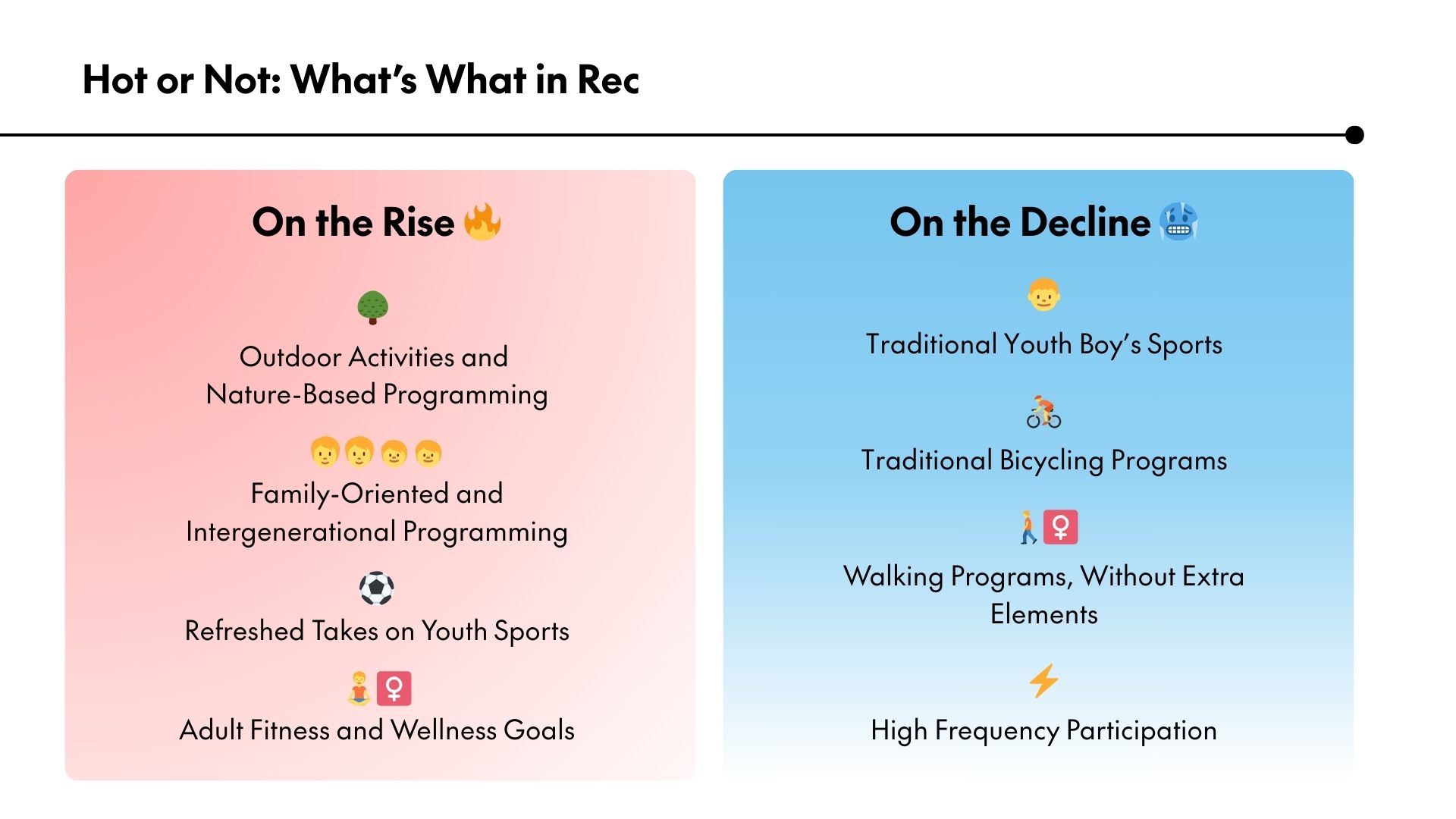
Regional Trends
Regional differences are creating distinct recreation cultures across the country, with each area developing signature approaches to programming:
Northeast
The Northeast is characterized with high density urban areas—this creates unique opportunities for programming that helps residents connect with limited natural spaces in meaningful ways.
Northeastern parks departments are implementing unique programs like:
- Winter Survival Series: Teaching cold-weather outdoor skills, like one offered in New York City’s Van Cortlandt Park
- Guided Snowshoeing or Cross-Country Skiing: Similar to ones offered by Boston Parks + Recreation Department
- Urban Wildlife Education Programs: Covering urban foraging tours, wilderness skills, or ecology workshops, like ones offered by multiple Pennsylvania-area cities
- Guided Walks, Steeped in History: With the abundance of history in the Northeast, cities like Philadelphia, Providence, and Boston all offer Cultural Heritage Walks
Southeast
The Southeast is characterized by a significant retiree population in many communities. This has made the region ripe for experimentation with programs that bridge generational gaps, like:
- Grandparent-Grandchild Days: Featuring activities explicitly designed for cross-generational participation, like kite-making workshops followed by flying sessions, like ones in Miami, Nashville, or Atlanta
- Morning Bird Fitness Classes: Scheduled in early morning hours and catered to seniors to avoid peak heat, often held in shaded outdoor pavilions, like ones in Tampa, Charleston, and Savannah
- Paddle Programs: Offering instruction in kayaking, canoeing, and paddleboarding on the region's abundant waterways, often with environmental education components, like ones in North Carolina
- Heritage Crafts Series: Where older community members teach traditional skills like quilting, woodworking, or southern cooking in workshop formats. This is popularized by geographies like Asheville or Virginia.
Midwest
The Midwest's strong community orientation creates fertile ground for programs that bring residents together while celebrating local natural and cultural resources. Midwestern parks departments find success with specific offerings like:
- Community Garden Programs: Where participants learn gardening basics while growing food for local food banks or for personal use, akin to programs run by Chicago Park District or Minneapolis Park & Recreation Board
- Prairie Restoration Teams: This combines volunteering with education about native ecosystems, similar to programs run across the Midwest, like this one in Polk County, Iowa
- Winter Adventure Series: Featuring ice fishing clinics, winter camping workshops, and snow shelter building, like ones run by Waukesha Park District in Wisconsin
- Hometown Olympics where families compete in modified versions of Olympic events adapted for all ages and abilities. This is currently offered in cities like Kansas City, Cincinnati, and Des Moines.
Mountain West
The region's abundant natural resources and outdoor tradition provide a foundation for innovation in nature-based programming, a trend that is booming. The Mountain West offers specialized programming such as:
- Adaptive Adventure Days: Making outdoor sports accessible to participants with disabilities through specialized equipment and instruction — many cities in Colorado and Utah have led this charge, like the Adaptive Recreation & Inclusion Services (A.R.I.S.E) in the City of Aurora, CO.
- Forest School + Outdoor Skill Camps where youth learn immerse themselves in nature while learning key outdoor skills, akin to programs across Wyoming and Montana, like ones offered by Lander Parks & Recreation
- Fat-Tire Biking Clinics: Introducing participants to winter biking on snow-covered trails, urging residents to get out even in the snow. Programs like this have been spearheaded by cities in Idaho and Montana, like Sun Valley and Missoula Parks and Recreation.
- Survival Skills Series: Teaching fire-making, shelter building, and other outdoor skills in graduated levels from beginner to advanced, like programs offered by Boulder, CO.
West Coast
The region's technology focus and wellness orientation create unique hybrid programming opportunities that blend digital and physical experiences.
- Tech-Enhanced Nature Walks: Utilizing augmented reality to provide information about plants, wildlife, and ecology as participants move through natural areas. East Bay Regional Park District in CA & Seattle have great ones!
- Climate-Action Recreation: Where activities like tree planting and habitat restoration are framed as fitness activities with environmental benefits, similar to programs run in San Diego or Los Angeles.
- Rooftop Garden Programs: Utilizing urban infrastructure for nature connection in densely developed areas, akin to programs in Seattle, San Francisco, and Portland.
- Mind-Body Outdoor Series: Combining yoga, meditation, and nature connection in structured programs that emphasize both physical and mental wellness. An example of these programs can be found in Oakland, Marin County, and San Diego.
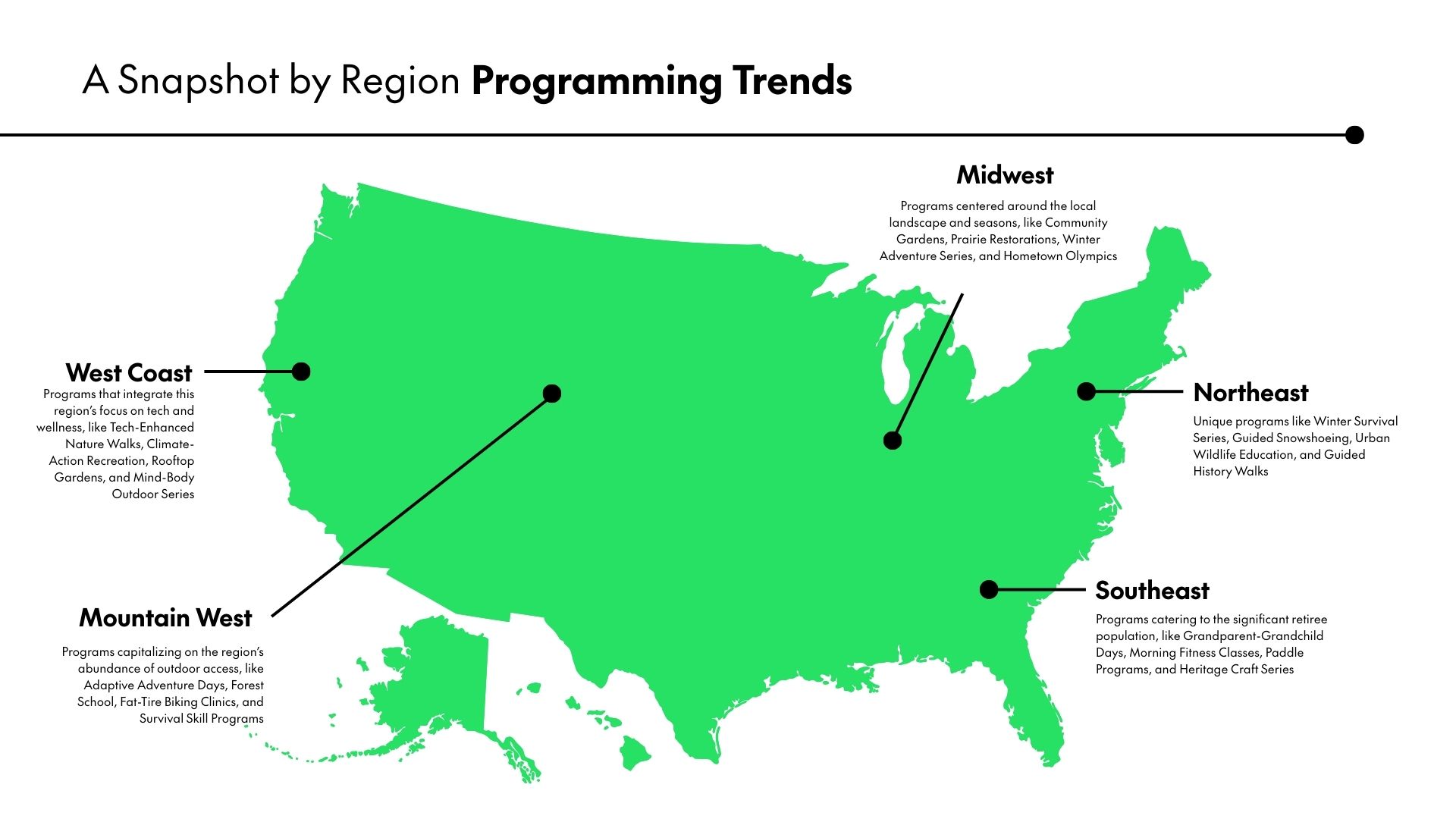
So, What Can You Do?
As you plan your programming calendar, these data-informed strategies can help position your department ahead of emerging trends:
1. Embrace the Multi-Generational Opportunity
The decline in youth-only boys programming paired with the rise in family-oriented activities suggests a significant opportunity:
- Design programs where different age groups participate together
- Create flexible formats that accommodate varied skill levels in the same program
- Consider scheduling that works for multiple age groups (evenings, weekends)
- Develop marketing that explicitly welcomes multiple generations
Programs that intentionally mix age groups often show stronger registration numbers and better retention than age-segregated alternatives.
💡Need inspiration? Check out what some of our partners at Rec are offering.
- Torrance, CO offers Clay Magic, Parent & Child to offer a pottery program that encourages fine motor skills, creativity, and multi-generational bonding
2. Build Outdoor Programming Beyond Activity-Specific Offerings
The continued strong outdoor participation numbers suggest opportunity in programs that:
- Introduce beginners to outdoor skills in accessible formats
- Connect outdoor time with specific wellness benefits
- Create structured nature experiences requiring minimal equipment
- Offer progressive skill development across multiple sessions
Even communities with limited natural resources can develop programming that connects residents with available green spaces in meaningful ways—see, rooftop gardens or urban wildlife programs.
💡Need inspiration? Check out what some of our partners at Rec are offering.
- Apex Park & Rec in Arvada, CO offers day excursions like a Denver Mob Tour, Grand Lake Scenic Tour, and a group Rockies game!
3. Rethink Traditional Youth Sports Frameworks
With the cornerstone of long-term youth boy’s sports participation declining, successful departments are:
- Shortening season lengths to reduce time commitments
- Creating flexible participation options beyond traditional team structures
- Emphasizing skill development and fun over competition
- Designing parent-child participation opportunities
Programs that recognize the changing relationship between families and organized sports often succeed where traditional models struggle.
💡Need inspiration? Check out what some of our partners at Rec are offering.
- Clarksville, IN offers Tico’s Tsunami Swimmers where parents and their children can swim together, learn water safety, and bond while building a life skill
4. Leverage Technology to Reduce Administrative Barriers
Modern recreation technology doesn't just simplify back-office operations—it creates entirely new programming possibilities:
- Digital registration and check-in reducing staff administrative burden
- Automated communications maintaining participant engagement
- Activity tracking enhancing program measurability
- Capacity and waitlist management ensuring optimal participant experiences
💡 Pro tip: Modern programming platforms (like ours) don't just manage registration—they can help identify emerging participation trends, track cross-program participation patterns, and make it easier than ever for residents to enroll in programs in your city.
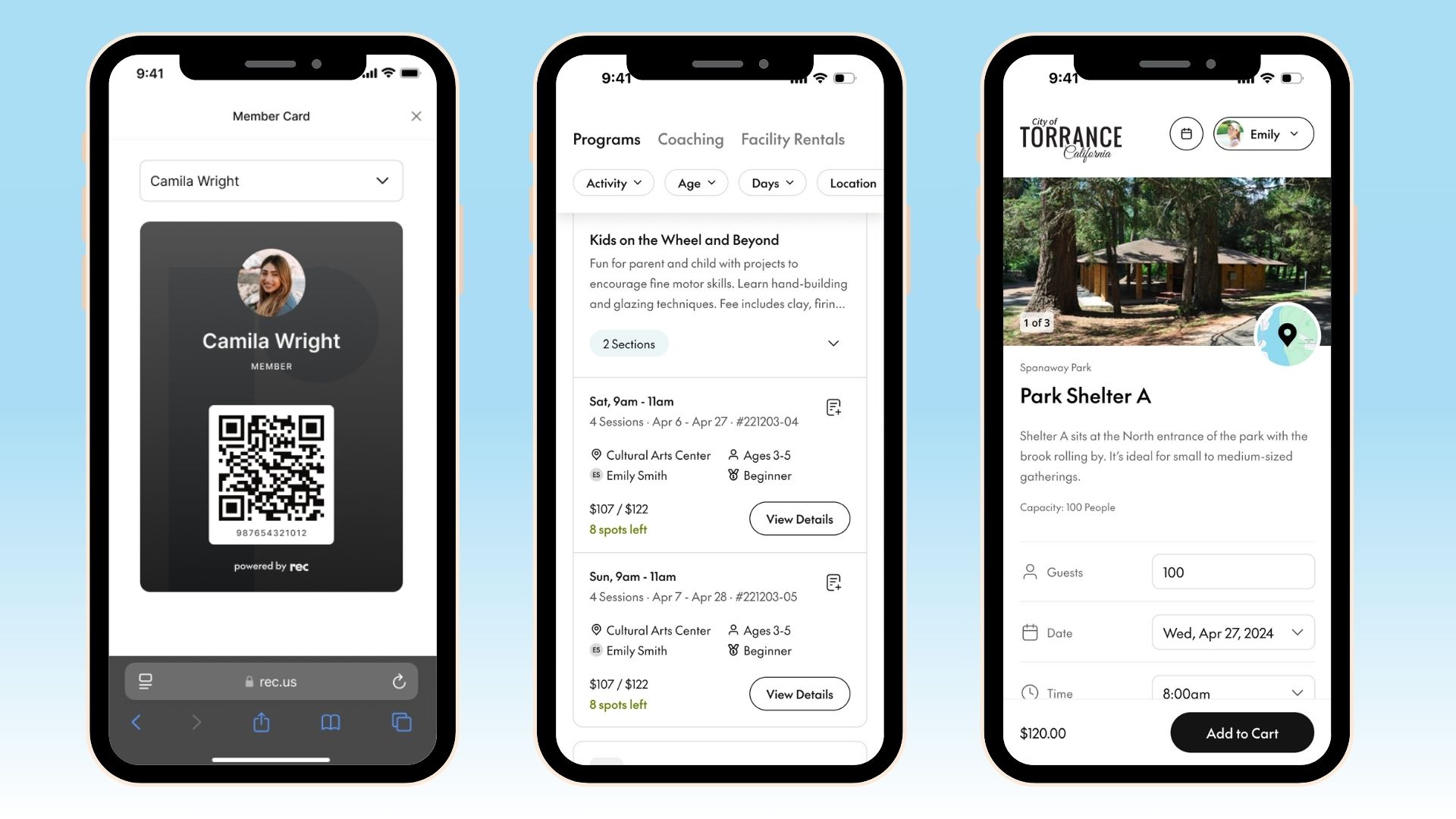
Proactive Programming Beats Reactive Scrambling
While there's no single "next pickleball" on the horizon, the data shows clear trends toward outdoor activities, intergenerational experiences, and more flexible participation models across all recreation categories.
Departments that recognize these patterns and design responsive programming—supported by efficient management systems—position themselves to meet evolving community needs without the administrative chaos that accompanied the pickleball explosion.
The bottom line: Recreation preferences will continue evolving, but the departments that thrive will be those that spend less time on administration and more time creating innovative programming that meets these emerging needs.
Looking to modernize your department's approach to program management? Our platform helps parks and recreation professionals streamline administration, create responsive programming that meets community needs, and provide intuitive user experiences your staff and residents will love. Contact us today to discover how technology can transform your program development from reactive to proactive.

.jpg)
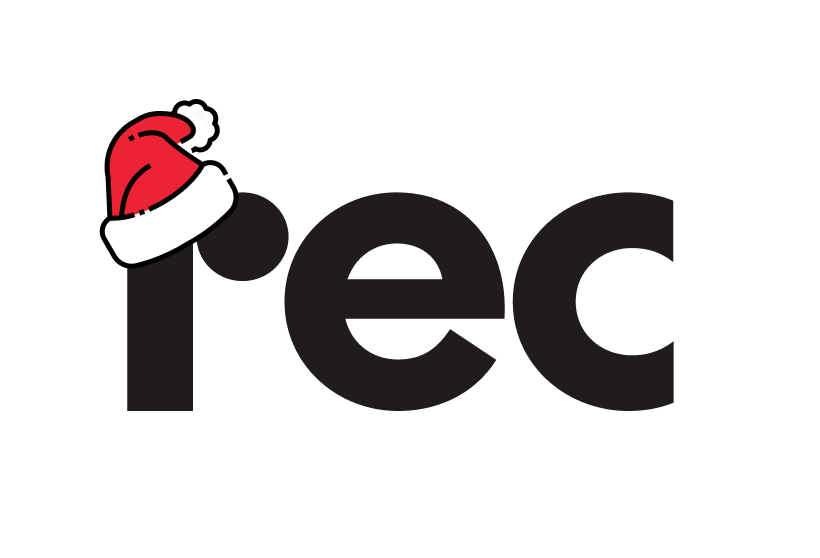
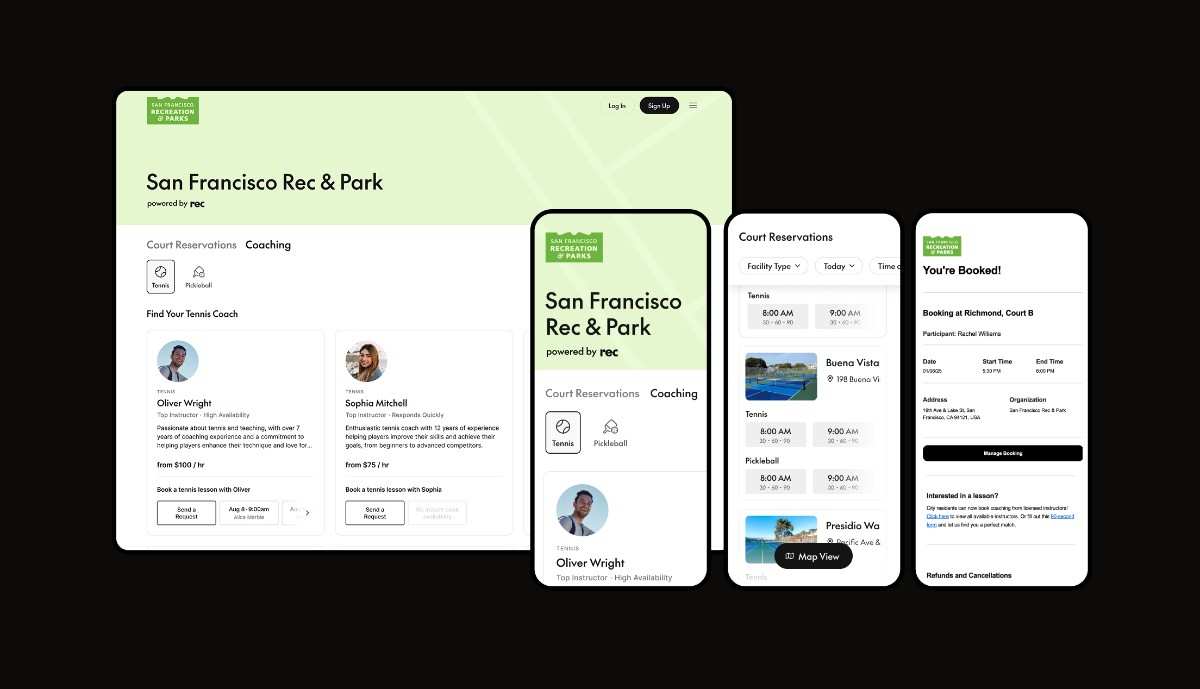
%20(1).jpg)